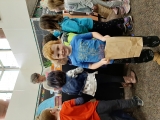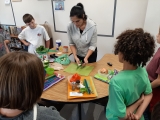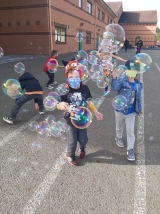-
Category 3
Selected in 2020
-
Grades: k - 5
School Setting: rural
Town Population: 25,000
Student Enrollment: 360
Student Demographics:
Black/African American: 2%
Teacher/Student Ratio: 1:17
White/Caucasian: 67%
Hispanic: 18%
Hawaiian/Pacific Islander: 1%
Asian: 2%
Native American: 2%
Other: 8%
% Reduced Lunch: 39%
% ELL Learners: 10%
Founded: 1991 -
PRINCIPAL:
Jennifer Allen -
CONTACT:
26211 72nd Ave NW
Stanwood, WA 98292
360-629-1270
jallen@stanwood.wednet.edu
Twin City Elementary School
Stanwood, WA
Our culture is kind, welcoming, collaborative and student-centered.
- Describe specific programs in place to ensure that families are involved in the success of your school and students.
- Our Twin City Elementary PTA has been very active in supporting our school and community. For the past two years they have encouraged families to sponsor membership for another person or staff member. This has resulted in our PTA membership growing substantially and engaged many more families in our school events. Our PTA has hosted Membership Socials where families are invited to provide feedback on all aspects of the school, such as our School Improvement Plan, new materials adoption, or school policies. In addition, our Twin City Elementary PTA provides many family engagement activities throughout the year, such as movie nights, BINGO, ice cream socials, and assemblies. Through strong communication and an active social media presence, we have been able to connect with our families who are not able to volunteer or be in the school regularly too. This connection allows all families to be informed and involved even when they cannot be physically present in the building.
- Describe the most successful activity your school has initiated to strengthen ties to your community.
- Twin City Elementary is the magnet school for our English Learners program so engaging our EL community has been top priority. We hired a bilingual secretary at Twin City Elementary, which made all the difference to our families. They now have a resource and advocate in the school that can speak their language and help them genuinely connect with their child’s teachers and our school events. One of our most successful activities to strengthen ties to our community is our culture event. This event gives students and their families the opportunity to share about themselves, thus giving us all a greater understanding of one another. Our culture event has expanded over the years and now includes students participating in classroom activities along with the evening displays. The true magic of our culture event is the realization that students have in understanding how much they have in common and making connections with one another in positive, inclusive ways.
- Describe your philosophy of school change or improvement.
- At Twin City Elementary, relationships are at the core of school change and improvement. We believe strongly that building positive relationships with our students, staff and families is the key to social and academic success. Our school has been successful at change because we have a shared vision of what we want to achieve. Staff are 100% committed to improvement and work together as a team to achieve our goals. The climate at Twin City Elementary is overwhelmingly positive and supportive and each person is valued for their perspective and contribution.
- What are your school’s top two goals for the next year?
- Given the impact that the COVID-19 pandemic has had on our students, staff and families, our top goal for next year will be to evaluate the academic gaps that students have after being out of a traditional school setting and determine how to address their needs. Our second goal is to create a plan to help students readjust to in person learning with a heavy emphasis on their social and emotional well-being.
- What is the single most important factor in the success of your school that others could replicate?
- Twin City Elementary is working to instill Tiger Pride in our students, staff and community by prioritizing relationships within our school community. We are all working toward the same goal of student success. Our staff truly sees all students as their students, no matter if they have direct contact with them or not. Tiger Pride is meaningful because it helps to establish a common identity among our students and staff, thus providing a link between many different cultures, religions and beliefs. By ensuring that all students and families are valued we create an environment that allows for risk-taking and extraordinary growth.
- Describe the program or initiative that has had the greatest positive effect on student achievement, including closing achievement or opportunity gaps, if applicable.
- The Title I/LAP program at Twin City Elementary has had a very positive impact on student achievement. The early intervention model focusing on providing the phonics, phonemic awareness and reading skills our students are missing to our K-2 students helps to close the gap for our struggling readers. Since our Title/LAP program has been limited to serving only English/Language Arts, our staff decided to revamp our curriculum materials to strengthen our core instruction in all academic areas. Through staff collaboration we were able to turn our Journeys and Math Expression materials into Google Slide presentations that include more connections to background knowledge, academic vocabulary, visual supports, and technology. Because all students benefit from richer core instruction we have experienced growth and student achievement in all our special populations.
- Explain how ESEA federal funds are used to support your improvement efforts.
- The funds that Twin City Elementary receives allows for continued professional growth and curriculum realignment. This ongoing cycle of improvements ensures that all our staff have the necessary tools needed to close the achievement gap. We have purchased curriculum materials in Spanish and provided parent education classes for our EL families on how to support their students and navigate the school environment. The ESEA funds have helped to purchase technology and online assessment tools that allow our staff to progress monitor our struggling readers in our Title/LAP program more frequently in order to make instructional adjustments at the individual student level.
- Identify the critical professional development activities you use to improve teaching and student learning.
- Over the course of several years our staff has focused on developing a positive growth mindset. Our professional learning through book studies and attending professional development outside of our district has allowed staff to share their new knowledge and support one another. Initiatives in education change so frequently and it felt like we were always being tempted to try the latest and newest idea. Instead, our staff has committed to holding one another accountable for being open minded to change and take something from each professional development opportunity to add to our school tool belt. This has included focusing on how to best engage students with poverty and adverse childhood experiences in mind.
- Describe how data is used to improve student achievement and inform decision making.
- At Twin City Elementary data is used as a springboard for our goals, discussions and decisions. While we use and respect what data can teach us, we also know that it is not the whole picture. The staff completed a book study on How Teachers Can Turn Data Into Action by Daniel R. Venables that changed our approach to data-driven decision making. In addition to our state assessments, we collect data three times per year at benchmark periods for all students in English/Language Arts and Math. Students are progress monitored between benchmark periods to demonstrate growth toward a goal. At Twin City Elementary we redesigned our master schedule to include dedicated time for interventions. Our Learning Lab is a time for teachers to work 1-1, small group, or whole group on a specific skill or concept that needs refinement. This is also a time for teachers to challenge students who are ready for the next step in their learning process.
- Describe your school culture and explain changes you’ve taken to improve it.
- At Twin City Elementary, everyone is involved and all are included. Our culture is kind, welcoming, collaborative and student-centered. While this can be said about many schools in our country, Twin City Elementary truly embodies what it means to care deeply about our students and each other. Over the years we have completed many professional development hours on how to build relationships with students and how best to engage them in the learning process. Our continued commitment to making school a safe, inviting place for students has resulted in social and academic success. When Twin City Elementary adopted the social/emotional curriculum offered by Character Strong, the culture of our school was refined through the lens of character development and what impact we have on one another. Character Strong has taught our students and staff to reflect on what it means to demonstrate many skills, such as courage, respect, kindness, empathy, and creativity.
Stats
-
Category 3
Selected in 2020
-
Grades: k - 5
School Setting: rural
Town Population: 25,000
Student Enrollment: 360
Student Demographics:
Black/African American: 2%
Teacher/Student Ratio: 1:17
White/Caucasian: 67%
Hispanic: 18%
Hawaiian/Pacific Islander: 1%
Asian: 2%
Native American: 2%
Other: 8%
% Reduced Lunch: 39%
% ELL Learners: 10%
Founded: 1991 -
PRINCIPAL:
Jennifer Allen -
CONTACT:
26211 72nd Ave NW
Stanwood, WA 98292
360-629-1270
jallen@stanwood.wednet.edu









